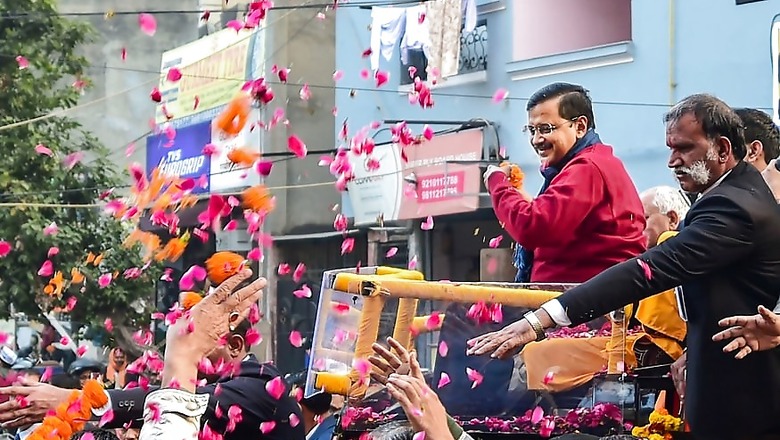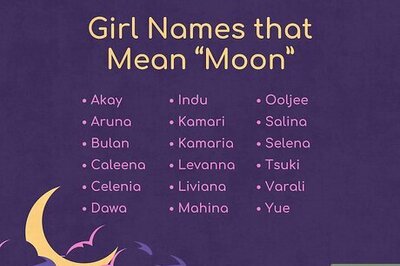
views
Delhi will vote to elect its new government on Saturday. As campaigning enters the last lap, three very visible points emerge. Firstly, chief minister Arvind Kejriwal’s Aam Aadmi Party (AAP) has put behind its rout in the 2019 Lok Sabha polls to start off as favourites for the assembly elections. Secondly, despite a late start, the Bharatiya Janata Party (BJP) campaign has peaked, closing the gap with AAP on many seats though there is absence of a charismatic face at the Delhi level. And thirdly, the Congress has frittered away the gains, in terms of vote percentage, it made in the 2017 municipal polls and last year’s parliamentary elections.
The general perception is that the BJP performs well in Delhi whenever there is a three-way division of votes as it has a static support base. With the Congress campaign failing to take off, AAP stands to gain just like it did in 2015, many poll pundits believe.
The BJP, however, is planning and executing its strategy, keeping in mind the fact that the Congress would not be able to ‘deliver’. So, the saffron party is taking its cue from the performance in the previous polls, when its vote share was much higher than the votes polled together by the Congress and AAP.
The BJP has commanded between 32% and 36% votes in Delhi in all the elections that followed the 1993 assembly polls: except in 1999 and the 2014 Lok Sabha polls. The Modi wave 1.0 in 2014 gave the party about 8% extra votes, taking its share to 44 per cent. In 2019, it jumped another 12 percentage points to 56%. This happened as floating voters backed the BJP and undoubtedly the name of Prime Minister Narendra Modi.
The last time the BJP got votes somewhere close to the 50% mark in an assembly election was in 1993, at the peak of its Ram Mandir movement. It had then polled around 47% votes. Will discontent brewing over the protests at Delhi’s Shaheen Bagh against the Citizenship Amendment Act (CAA) prove to be as emotively powerful an issue as the temple campaign? Undoubtedly, the BJP leadership wants that to happen.
Speeches by party leaders from PM Modi downwards have been targeted at whipping up sentiments connected to the “threat to national unity which the Shaheen Bagh protests hold”. The exceptionally vitriolic campaign by some of its leaders like Kapil Mishra, Parvesh Verma and Anurag Thakur are not sought to be condemned but rather condoned by providing them other platforms to put forth their views.
West Delhi MP Verma, who was banned from campaigning by the Election Commission, was assigned to initiate the debate on the motion of thanks to the President’s address in the Lok Sabha on Monday. He made three main points – attack on the Nehru-Gandhis, attack on the Shaheen Bagh protesters, and attack on AAP’s policies of subsidising civic services with a list of pro-people policies which the BJP plans to initiate if voted to power, including making wheat flour available at Rs 2 per kg for the poor.
Other than the poll narrative, what has helped the BJP add impetus to its campaign is the selection of candidates. The party has in most cases overlooked recommendations of local leaders pushing for their favourities and gone strictly by the findings of its internal surveys on the strengths and weaknesses of the nominees.
Coming back to the poll narrative, since Shaheen Bagh is part of the ideological conflict between the Left and the Right, the cadres of the Rashtriya Swayamsevak Sangh (RSS) would also not like to leave anything to chance and let those “standing with Shaheen Bagh protesters” win the polls. A loss for the BJP in Delhi would mean a big setback to the Sangh agenda being promoted so consistently by the Narendra Modi government.
On the other hand, Kejriwal is fighting the polls on the basis of his personal appeal and his campaign is fuelled by the freebies which his government has given in the past few months. However, Shaheen Bagh protests are proving to be an albatross around his neck. He has been unable to either own or disown them in the face of persistent attacks launched by the BJP.
The other challenge which Kejriwal is facing is a lack of compelling campaigners. He is the only one from his party who has canvassed outside his constituency, appealing for the votes for his candidates. In the absence of stage performers like Kumar Vishwas, who played a big role in both the 2013 and 2015 electioneering, AAP has decided against holding public meetings and is depending completely on Kejriwal’s roadshows and a very intensive campaign on social media.
Kejriwal is also drawing strength, in addition to the beneficiaries of the freebie schemes, from such people who were recruited as paid volunteers for various government programmes during the past five years including the odd-even vehicle rationing scheme last November. For them, a loss of AAP in the polls would mean a loss of livelihood, and they would certainly resist the BJP tooth and nail.
After Modi’s entry in the campaign scene, Kejriwal is bound to create a David- versus-Goliath hype. The challenge for the BJP is to not let AAP play the victim card effectively, and keep up the tempo of its campaign aimed at polarising voters. For the BJP to win the polls, “love for the nation” will have to trend briskly over the “lure for freebies”.
(The writer is a senior journalist and political analyst. Views expressed are personal.)


















Comments
0 comment